

Internment during World War II Australia. In 1939 thousands of Australian residents suddenly found themselves identified as potential threats to Australia's national security.
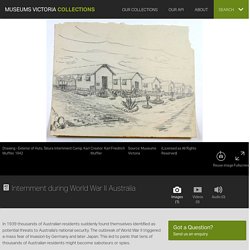
The outbreak of World War II triggered a mass fear of invasion by Germany and later Japan. This led to panic that tens of thousands of Australian residents might become saboteurs or spies. Government regulations required 'enemy aliens' to register and limit their travel to between work and home and within a specified distance from the local post office. They had to obtain permission from the authorities to travel further or change residence. The most dramatic response was the internment of many German, Italian and Japanese residents in camps - overseas and Australian-born, and naturalised British subjects. A further 8000 people were sent to Australia to be interned after being detained overseas by Australia's allies. Internees were usually separated from their families and tried to find ways to keep themselves occupied.
The Cowra Breakout - ANZAC Day Commemoration Committee. World War II Enemy Alien Control Program Overview. Immediately after the bombing of Pearl Harbor, President Roosevelt issued Presidential Proclamations 2525, 2526, and 2527 to authorize the United States to detain allegedly potentially dangerous enemy aliens.

The FBI and other law enforcement agencies arrested thousands of suspected enemy aliens, mostly individuals of German, Italian, or Japanese ancestry, living throughout the United States. Japanese Internment Camps. Army-directed evacuations began on March 24.
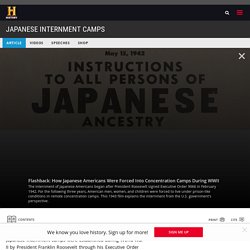
People had six days notice to dispose of their belongings other than what they could carry. Anyone who was at least 1/16th Japanese was evacuated, including 17,000 children under 10, as well as several thousand elderly and handicapped. Japanese Americans reported to centers near their homes. From there they were transported to a relocation center where they might live for months before transfer to a permanent wartime residence. These centers were located in remote areas, often reconfigured fairgrounds and racetracks featuring buildings not meant for human habitation, like horse stalls or cow sheds, that had been converted for that purpose. – National Archives of Australia. Cover of An Illustrated Diary of Australian Internment by Edmond Samuels (NAA: A1336, 7597) In the interests of national security the Australian Government interned thousands of men, women and children during World War I and World War II.

Most of those interned were classed as 'enemy aliens', that is, nationals of countries at war with Australia. Internees were accommodated in camps around Australia, often in remote locations. The National Archives holds records about these camps, their development and administration, as well as about the government policy that established them. The Treatment of Soviet POWs: Starvation, Disease, and Shootings, June 1941–January 1942. What Life Was Like For POWs In Europe During The Second World War. Prisoners of the Japanese: Civilian internees, Pacific and South-East Asia.
History - World Wars: Japan's Quest for Empire. Hirohito. Hirohito (1901-1989) was emperor of Japan from 1926 until his death in 1989.

He took over at a time of rising democratic sentiment, but his country soon turned toward ultra-nationalism and militarism. During World War II (1939-45), Japan attacked nearly all of its Asian neighbors, allied itself with Nazi Germany and launched a surprise assault on the U.S. naval base at Pearl Harbor. Though Hirohito later portrayed himself as a virtually powerless constitutional monarch, many scholars have come to believe he played an active role in the war effort. After Japan’s surrender in 1945, he became a figurehead with no political power. Japan's Quest for Power and World War II in Asia. The World at War: 1931-1945 Economic Background.
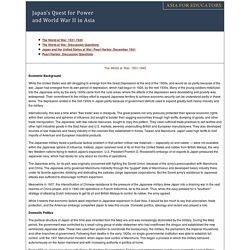
Japan in WW2. The war against Japan provided the Allies with completely new problems as they faced up to an enemy with completely different tactics.
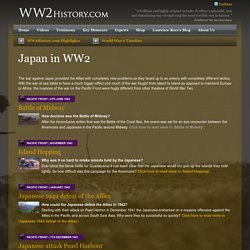
With the war at sea liable to have a much bigger effect and much of the war fought from island to island as opposed to mainland Europe or Africa, the nuances of the war on the Pacific Front were hugly different from other theatres of World War Two. Pacific Front | November 1943 Island Hopping Why was it so hard to retake islands held by the Japanese? Ever since the fierce battle for Guadalcanal it had been clear that the Japanese would not give up the islands they held lightly. So how difficult was this campaign for the Americans? Click here to read more in 'Island Hopping'.
World War II History: WW2 in the Pacific (Japan) for Kids. History >> World War 2 for Kids There were two major places where World War II took place.

These places are sometimes called theaters of war. One theater of World War II was in Europe, the other was in the Pacific. The Pacific theater of war included Japan, China, Korea, the Philippines, and many more islands and countries in Southeast Asia. Japanese Battleships - Japan had a powerful navy Photo by Unknown. National Geographic Society. World War II in the Pacific. Military History Online - WWII Western Theater Home. Breakout From the Hedgerows: A Lesson in Ingenuity by Walter S.
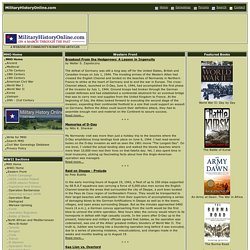
Zapotoczny The defeat of Germany was still a long way off for the United States, British and Canadian troops on July 1, 1944. The D-Day Story, Portsmouth – How do you get an army across the English Channel and into France when your enemy is well armed, well trained and expecting you? Find out how at the D-Day Story, Portsmouth. D-Day - Invasion, Facts & Significance. During World War II (1939-1945), the Battle of Normandy, which lasted from June 1944 to August 1944, resulted in the Allied liberation of Western Europe from Nazi Germany’s control.

Codenamed Operation Overlord, the battle began on June 6, 1944, also known as D-Day, when some 156,000 American, British and Canadian forces landed on five beaches along a 50-mile stretch of the heavily fortified coast of France’s Normandy region. The invasion was one of the largest amphibious military assaults in history and required extensive planning. Prior to D-Day, the Allies conducted a large-scale deception campaign designed to mislead the Germans about the intended invasion target. WWII in Europe: The Western Front. Australia & WWII. Australian Involvement In The Second World War. Served Overseas: 575,799 Died: 39,429 Wounded: 66,563 Men awarded the Victoria Cross: 20. Second World War, 1939–45. On 3 September 1939 Prime Minister Robert Gordon Menzies announced the beginning of Australia's involvement in the Second World War on every national and commercial radio station in Australia. Almost a million Australians, both men and women, served in the Second World War.
They fought in campaigns against Germany and Italy in Europe, the Mediterranean and North Africa, as well as against Japan in south-east Asia and other parts of the Pacific. The Australian mainland came under direct attack for the first time, as Japanese aircraft bombed towns in north-west Australia and Japanese midget submarines attacked Sydney harbour. The Kokoda Track. The Burma-Thailand Railway and Hellfire Pass. Australia and the Second World War. Racism and Nazi Racial Ideology - The Holocaust. History - World Wars: The Nazi Racial State. Antisemitic Legislation 1933–1939. World War II for Kids: Causes of WW2. World War Two - Causes. Loading... Listen to the audio of this post here: World War Two began in September 1939 when Britain and France declared war on Germany following Germany’s invasion of Poland. Although the outbreak of war was triggered by Germany’s invasion of Poland, the causes of World War 2 are more complex. Treaty of Versailles In 1919, Lloyd George of England, Orlando of Italy, Clemenceau of France and Woodrow Wilson from the US met to discuss how Germany was to be made to pay for the damage world war one had caused.
Woodrow Wilson wanted a treaty based on his 14-point plan which he believed would bring peace to Europe. Georges Clemenceau wanted revenge. Lloyd George personally agreed with Wilson but knew that the British public agreed with Clemenceau. Causes of World War Two. The causes of World War Two can be divided into long term causes and short term causes. There can be little doubt that one of the long term causes of the war was the anger felt in Weimar Germany that was caused by the Treaty of Versailles. Another long term cause was the obvious inability of the League of Nations to deal with major international issues. In the 1930’s these would have been inManchuria and Abyssinia. In both conflicts the League showed that it was unable to control those powers that worked outside of accepted international law.
In the case of Manchuria it was Japan and in Abyssinia it was Mussolini’s Italy. With such apparent weakness, Hitler must have known that at the very least he could push the boundaries and see what he could get away with. Examine the Causes of World War II. Media – The Holocaust Explained: Designed for schools. Nazi Propaganda (1933-1945) Nazi Propaganda: 1933-1945 Propaganda was central to National Socialist Germany. This page is a collection of English translations of Nazi propaganda for the period 1933-1945, part of a larger site on German propaganda. The goal is to help people understand the great totalitarian systems of the twentieth century by giving them access to primary material. The archive is substantial. If you are looking for something specific, try the search function. Nazi Propaganda. In 1924, Adolf Hitler wrote that propaganda’s “task is not to make an objective study of the truth, in so far as it favors the enemy, and then set it before the masses with academic fairness; its task is to serve our own right, always and unflinchingly.”
World War II resources (Virtual Programs & Services, Library of Congress) Compiled by Mark F. World politics explainer: The Great War (WWI) World War II: the Australian experience. Australian War Memorial collection. Home front: Second World War. Digger recounts brutal life in WWII prison camp. Updated Media player: "Space" to play, "M" to mute, "left" and "right" to seek. World War II - Battles, Facts, Videos & Pictures - History.com. World War II Database. World War II General Resources. WWII Web Sites. Inside World War II Interactive. The bombing of Darwin - Fact sheet 195. Japanese air raids on Darwin and northern Australia, 1942–43 On 19 February 1942 mainland Australia came under attack for the first time when Japanese forces mounted two air raids on Darwin.
The two attacks, which were planned and led by the commander responsible for the attack on Pearl Harbor ten weeks earlier, involved 188 attack aircraft which were launched from four Japanese aircraft-carriers in the Timor Sea, and a second raid of 54 land-based bombers. The carrier battle group consisted additionally of two heavy cruisers, one light cruiser, seven destroyers, three submarines, and two other heavy cruisers on distant cover. History: World War Two. Home WWII. Unlike World War I, the Second World War was waged much closer to home. This time, they were facing an enemy in their own Pacific neighbourhood, aiming to invade the mainland.
Civilians had to prepare for the invasion, and they faced years of hardships and shortages. Australia entered the war with only a small army: it had to urgently build a large fighting force. Abroad WWII. Australian War Memorial, London. Second World War, 1939–45. Australia and the Second World War.